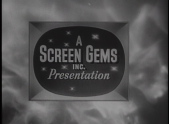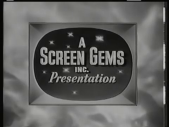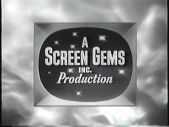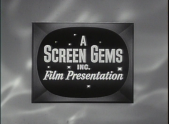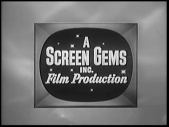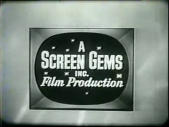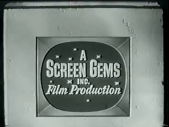Screen Gems Television
Jump to navigation
Jump to search
Logo descriptions by James Fabiano, Jason Jones, and Shadeed A. Kelly
Logo captures by Eric S., V of Doom, Shadeed A. Kelly, JohnnyL80, mr3urious, Michael Bass, TrickyMario7654, snelfu, Logoboy95, Gilblitz112, Sagan Blob, TheEriccorpinc, SloshedMail, Pygmalion X, and Brendan Richards
Additional edits by Shadeed A. Kelly, kidinbed,CD20 Superness, V of Doom, Lee Cremeans, Brendan Richards, Kramden II, ccateni28, mario9000seven, and Unnepad
Video captures courtesy of JohnnyL80, Eric S., Mike Stidham, Jordan Rios, supremetaco, mcydodge919, ClassicTVMan1981X, DanDMan16, and SloshedMail
Background: Screen Gems was revived as a television subsidiary by Columbia Pictures in 1948. It was formed when Columbia acquired Pioneer Telefilms, a television commercial company founded in 1947 by Ralph M. Cohn, the son of Columbia Pictures co-founder, Jack Cohn, and the nephew of longtime Columbia Pictures president and co-founder, Harry Cohn. Pioneer Telefilms was renamed to Screen Gems after the acquisition. It was responsible for television production, TV movies, syndicating the Columbia Pictures movie library, and starting in 1958, The Three Stooges shorts starting with the Curly series. Screen Gems became a fully-fledged studio in 1951 by moving into Telefilm syndication and later into television production in 1952. On July 1, 1956, Columbia studio veteran Irving Briskin formed Briskin Productions to oversee all of Screen Gems' productions. On December 10, 1956, Screen Gems acquired television syndication company Hygo Television Films (a.k.a. "Serials Inc.") as well as its affiliated company, United Television Films, Inc. On August 2, 1957, Screen Gems agreed to syndicate the Universal Horror Package from Universal-International for 10 years under the names Shock and Son of Shock. From 1957-1966, Screen Gems held a 20% stake in Hanna-Barbera and acted as their distributor; Screen Gems (and later, Columbia Pictures itself) also owned the distribution rights to The Flintstones until the 1980s. In January 1961, Columbia Pictures Corporation and Screen Gems, Inc. were split into separate companies, when the former studio sold 11% of the latter's stock to the public. On December 23, 1968, Screen Gems merged with its parent Columbia Pictures Corporation and the whole organization was reincorporated as "Columbia Pictures Industries, Inc.". On May 6, 1974, Screen Gems was reincorporated as "Columbia Pictures Television" (now "Sony Pictures Television"). The name was suggested by David Gerber, the then-current president of Columbia's television division.
1st Logo
(April 1951-1952, December 14, 1957-1974)
Logo: Superimposed over the screen, we see in-credit text that reads:
Variants:
FX/SFX: None or the cross-fading. Except on Days of Our Lives, where the text scrolls.
Music/Sounds/Voice-over: The end-title theme from any show. In the game show Line 'em Up, a voice-over says "Line 'em Up is a Screen Gems production in association with CFTO TV enclosing".
Availability: Uncommon.
Editor's Note: None.
2nd Logo
(October 2, 1952-April 4, 1956)
Nicknames: "The TV Tube", "Screen Gems-on-TV"
Logo: On the same light gray background seen on the last logo, we see a TV tube-like shape that's outlined in dark gray and filled in black. There are about eight stars shining inside (like stars in the sky) around the phrase "A SCREEN GEMS INC. Presentation" or "A SCREEN GEMS INC. Production".
Variants:
FX/SFX: The little stars twinkling.
Music/Sounds: The end title theme of any show.
Availability: Ultra rare.
Editor's Note: The logo fits well with the company name as the "SCREEN" is the TV tube, and the "GEMS" are the stars on the screen. It's a rather peculiar concept that was shelved in favor of the "Torch Lady" years later.
3rd Logo
(August 27, 1955-June 24, 1960)
Nickname: "Torch Lady"
Logo: Like the 1942 version of the 1936 Columbia Pictures logo, we see a lady (Columbia, a representation of the USA) holding a light torch on top a pedestal with a backdrop of clouds over her. The Torch Lady's head and upper body is between the words "SCREEN GEMS" with the letter "A" in Vivaldi font above it and "FILM PRESENTATION" or "FILM PRODUCTION" below it. The byline "TELEVISION SUBSIDIARY COLUMBIA PICTURES CORPORATION" appears below that.
Trivia: The Torch Lady, aka Columbia, is played by Pittsburgh native Jane Chester Bartholomew, who was discovered by Harry Cohn. (After she left acting in the '60s, Mrs. Bartholomew became a nursing inspector with the Chicago Board of Health. She passed away in 2012.)
Variant: There is a special variant for the 10th Anniversary of Screen Gems. The logo is the same, except for the text "10ᵀᴴ ANNIVERSARY FILM PROGRAM" (or "FILM PRESENTATION") seen below in place of the standard text.
FX/SFX: The lady's torch "shining".
Music/Sounds/Voice-over:
Music/Sounds Variant: When the movie 20 Million Miles to Earth premiered on television, Screen Gems plastered the Columbia Pictures logo, keeping the fanfare intact.
Availability: Rare.
Editor's Note: This was the first use of the "Torch Lady" for television. It's mostly a well-liked logo, but some viewers in their youth were put off by the loud and dramatic nature of the fanfare heard on some shows, which has been referred to by some as the "Fanfare of Doom".
4th Logo
(September 3, 1960-July 7, 1963)
Nickname: "Torch Lady II"
Logo: Same as the 1955 logo, excluding the clouds and the additional captions. Only the name "SCREEN GEMS" remains, and the words are smaller and somewhat stretched out, and the words are shown on each side of the lower body and legs.
Trivia: The Torch Lady here is also played by Jane Chester Bartholomew..
Variants:
FX/SFX: The lady's torch "shining".
Music/Sounds/Voice-over: Usually, the end title theme from any show has played over this with Harry Cohn, the longtime president of Columbia Pictures announcing:
Availability: Rare.
Editor's Note: It's more of the same from the previous logo, but with less clutter.
5th Logo
(September 15, 1963-June 25, 1965)
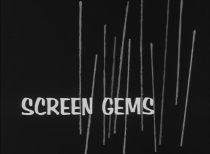
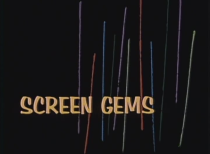
<iframe height="167" src="http://wikifoundrytools.com/wiki/closinglogos/widget/unknown/aaeb67fb4ddcb952dd26c62348d09b420e80ae8d" width="222"></iframe><iframe height="167" src="http://wikifoundrytools.com/wiki/closinglogos/widget/unknown/6484b870627f06f58c5635d1a62bb9b5e043c09f" width="222"></iframe><iframe frameborder="0" height="167" src="http://wikifoundrytools.com/wiki/closinglogos/widget/genericvideo/332f98a866252d4b2391f862ecc01b2e9ed2df4a" width="295"></iframe>
Nickname: "The Dancing Sticks"
Logo: Eleven animated lines "drop down" at the right of the black screen to ascending jazz notes as a swarm of circles scatter near the middle of the left side leaving behind the words "SCREEN GEMS" in a Benguiat Frisky font. (These circles were what one rec.arts.animation post described as the "spotlights". The "stars" may come from the fact that the circles sparkle like stars.) As this happens, the lines shrink somewhat and spread out, filling the right half and shaking slightly back and forth.
Variant: When filmed and broadcast in color, the sticks and the dots are rainbow colors.
FX/SFX: The lines dropping and shrinking.
Music/Sounds/Voice-over: An 8-note jazzy trumpet fanfare that ascends as the sticks drop in, and ends with a 5-note stinger when the logo finishes. An announcer states that the production is "A Screen Gems Production" (for shows produced in-house) or "A Screen Gems Presentation" (for co-productions with other companies) near the end.
Music/Sounds/Voice-over Variants:
Availability: Rare.
Editor's Note: A straight example of early 60s art decor. Advertising in the 1960s commonly used this style of art.
6th Logo
(September 13, 1965-August 29, 1974)
Nicknames: "S from Hell", "The Spiral S", "The Filmstrip S", "The Spiral S from Hell", "The Personification of All That Is Evil"
Logo: On a yellow background, two red parallelograms (or lines) come from the top and bottom of the screen, and the upper one is at a distance while the lower is closer. They fly towards each other, and the higher moves forward while the lower backs away. As they do so, they grow in length and wrap around a space where a red dot appears, forming a stylized "S". Under that, the text "SCREEN GEMS" zooms in.
Trivia:
Variants:
FX/SFX: The parallelograms wrapping around the dot, and the name "SCREEN GEMS" zooming in.
Music/Sounds:
Music/Sounds Variants:
Availability: Pretty common.
Editor's Note: For a logo from the Sixties, this features very smooth animation, especially when compared to other logos of the time. However, this logo has gained somewhat of a cult following due to its notoriety for scaring some viewers, even enough to spawn a short mockumentary in 2010 called <a href="https://io9.gizmodo.com/5797378/watch-the-s-from-hell-a-short-documentary-about-people-scared-of-the-screen-gems-logo" target="_self">The S from Hell</a>.
Logo captures by Eric S., V of Doom, Shadeed A. Kelly, JohnnyL80, mr3urious, Michael Bass, TrickyMario7654, snelfu, Logoboy95, Gilblitz112, Sagan Blob, TheEriccorpinc, SloshedMail, Pygmalion X, and Brendan Richards
Additional edits by Shadeed A. Kelly, kidinbed,CD20 Superness, V of Doom, Lee Cremeans, Brendan Richards, Kramden II, ccateni28, mario9000seven, and Unnepad
Video captures courtesy of JohnnyL80, Eric S., Mike Stidham, Jordan Rios, supremetaco, mcydodge919, ClassicTVMan1981X, DanDMan16, and SloshedMail
Background: Screen Gems was revived as a television subsidiary by Columbia Pictures in 1948. It was formed when Columbia acquired Pioneer Telefilms, a television commercial company founded in 1947 by Ralph M. Cohn, the son of Columbia Pictures co-founder, Jack Cohn, and the nephew of longtime Columbia Pictures president and co-founder, Harry Cohn. Pioneer Telefilms was renamed to Screen Gems after the acquisition. It was responsible for television production, TV movies, syndicating the Columbia Pictures movie library, and starting in 1958, The Three Stooges shorts starting with the Curly series. Screen Gems became a fully-fledged studio in 1951 by moving into Telefilm syndication and later into television production in 1952. On July 1, 1956, Columbia studio veteran Irving Briskin formed Briskin Productions to oversee all of Screen Gems' productions. On December 10, 1956, Screen Gems acquired television syndication company Hygo Television Films (a.k.a. "Serials Inc.") as well as its affiliated company, United Television Films, Inc. On August 2, 1957, Screen Gems agreed to syndicate the Universal Horror Package from Universal-International for 10 years under the names Shock and Son of Shock. From 1957-1966, Screen Gems held a 20% stake in Hanna-Barbera and acted as their distributor; Screen Gems (and later, Columbia Pictures itself) also owned the distribution rights to The Flintstones until the 1980s. In January 1961, Columbia Pictures Corporation and Screen Gems, Inc. were split into separate companies, when the former studio sold 11% of the latter's stock to the public. On December 23, 1968, Screen Gems merged with its parent Columbia Pictures Corporation and the whole organization was reincorporated as "Columbia Pictures Industries, Inc.". On May 6, 1974, Screen Gems was reincorporated as "Columbia Pictures Television" (now "Sony Pictures Television"). The name was suggested by David Gerber, the then-current president of Columbia's television division.
1st Logo
(April 1951-1952, December 14, 1957-1974)
Screen Gems, Inc. ProductionCorday Productions and Screen Gems (1965-1974)
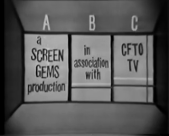 Screen Gems (1959, in-credit)
Screen Gems (1959, in-credit)
Screen Gems Television (1962)Screen Gems Productions (in-credit)Screen Gems (The Flintstones 1962)Screen Gems (1962)John Guedel Productions/Screen Gems Television (1963)
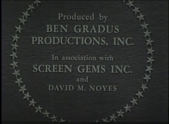
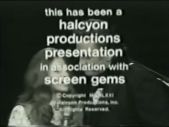

 Screen Gems (1959, in-credit)
Screen Gems (1959, in-credit)Screen Gems Television (1962)Screen Gems Productions (in-credit)Screen Gems (The Flintstones 1962)Screen Gems (1962)John Guedel Productions/Screen Gems Television (1963)


Logo: Superimposed over the screen, we see in-credit text that reads:
A
SCREEN GEMS, INC.
PRODUCTION
SCREEN GEMS, INC.
PRODUCTION
Variants:
- On Days of Our Lives, the text would read as "A CORDAY PRODUCTIONS, SCREEN GEMS PRESENTATION".
- For those co-produced by Hanna-Barbera, it would say "A SCREEN GEMS FILM PRESENTATION, TELEVISION SUBSIDIARY COLUMBIA PICTURES CORPORATION".
- On Decision: The Conflicts of Harry S. Truman, under the Ben Gradus Productions text says, "In association with SCREEN GEMS INC. and DAVID M. NOYES".
- On the short-lived game show Line 'em Up, in the first reel says "a SCREEN GEMS production".
- On The Jetsons episode "The Coming of Astro", the letter "A" isn't shown next to the words "SCREEN GEMS" (This version can still be seen intact on The Jetsons episode on Boomerang and Amazon Video on Demand).
FX/SFX: None or the cross-fading. Except on Days of Our Lives, where the text scrolls.
Music/Sounds/Voice-over: The end-title theme from any show. In the game show Line 'em Up, a voice-over says "Line 'em Up is a Screen Gems production in association with CFTO TV enclosing".
Availability: Uncommon.
- It's currently seen on the first two seasons of The Flintstones on Boomerang, MeTV, and DVD's of the show.
- It was also seen on Top Cat and some first season episodes of The Jetsons and early seasons of The Ford Theatre.
- The 1964 in-credit variant can be seen in the documentary series Decision: The Conflicts of Harry S. Truman episode "Dialogue with the Future, Part I", currently on C-SPAN's YouTube channel.
Editor's Note: None.
2nd Logo
(October 2, 1952-April 4, 1956)
<iframe height="150" src="http://wikifoundrytools.com/wiki/closinglogos/widget/unknown/ca26aaa0ccb894a20812cae0ee94f041d6819711" width="199"></iframe><iframe height="150" src="http://wikifoundrytools.com/wiki/closinglogos/widget/unknown/525d7483865330b5b048ff5e472500cd0e018292" width="199"></iframe><iframe height="150" src="http://wikifoundrytools.com/wiki/closinglogos/widget/unknown/bbf54b69747b219377ecd25e4edf88fba3948532" width="199"></iframe>
Nicknames: "The TV Tube", "Screen Gems-on-TV"
Logo: On the same light gray background seen on the last logo, we see a TV tube-like shape that's outlined in dark gray and filled in black. There are about eight stars shining inside (like stars in the sky) around the phrase "A SCREEN GEMS INC. Presentation" or "A SCREEN GEMS INC. Production".
Variants:
- There is one version where the stars shining are more animated and differently shaped. Also, there isn't any glow surrounding them.
- From late 1954 to early 1956, the word "Film" is added inside the tube.
FX/SFX: The little stars twinkling.
Music/Sounds: The end title theme of any show.
Availability: Ultra rare.
- It originally appeared on The Ford Television Theatre, Captain Midnight, Father Knows Best, The Adventures of Rin Tin Tin, among other shows.
- Currently seen on the complete first & second season of Father Knows Best on DVD.
Editor's Note: The logo fits well with the company name as the "SCREEN" is the TV tube, and the "GEMS" are the stars on the screen. It's a rather peculiar concept that was shelved in favor of the "Torch Lady" years later.
3rd Logo
(August 27, 1955-June 24, 1960)
Screen Gems Television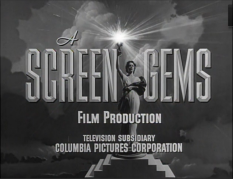 Screen Gems Television (1958, 10th Anniversary Variant)
Screen Gems Television (1958, 10th Anniversary Variant)
<iframe height="164" src="http://wikifoundrytools.com/wiki/closinglogos/widget/youtubevideo/a3b7f8810ecda45e6eee8160540d9bf4757abb85" width="218"></iframe><iframe frameborder="0" height="164" src="http://wikifoundrytools.com/wiki/closinglogos/widget/genericvideo/58b33a8fe41567b66edbc1dc1616268319759197" width="292"></iframe><iframe height="165" src="http://wikifoundrytools.com/wiki/closinglogos/widget/unknown/851c88a9620f707f81fd91e6b4e862feb81e0798" width="218"></iframe>
 Screen Gems Television (1958, 10th Anniversary Variant)
Screen Gems Television (1958, 10th Anniversary Variant)<iframe height="164" src="http://wikifoundrytools.com/wiki/closinglogos/widget/youtubevideo/a3b7f8810ecda45e6eee8160540d9bf4757abb85" width="218"></iframe><iframe frameborder="0" height="164" src="http://wikifoundrytools.com/wiki/closinglogos/widget/genericvideo/58b33a8fe41567b66edbc1dc1616268319759197" width="292"></iframe><iframe height="165" src="http://wikifoundrytools.com/wiki/closinglogos/widget/unknown/851c88a9620f707f81fd91e6b4e862feb81e0798" width="218"></iframe>
Nickname: "Torch Lady"
Logo: Like the 1942 version of the 1936 Columbia Pictures logo, we see a lady (Columbia, a representation of the USA) holding a light torch on top a pedestal with a backdrop of clouds over her. The Torch Lady's head and upper body is between the words "SCREEN GEMS" with the letter "A" in Vivaldi font above it and "FILM PRESENTATION" or "FILM PRODUCTION" below it. The byline "TELEVISION SUBSIDIARY COLUMBIA PICTURES CORPORATION" appears below that.
Trivia: The Torch Lady, aka Columbia, is played by Pittsburgh native Jane Chester Bartholomew, who was discovered by Harry Cohn. (After she left acting in the '60s, Mrs. Bartholomew became a nursing inspector with the Chicago Board of Health. She passed away in 2012.)
Variant: There is a special variant for the 10th Anniversary of Screen Gems. The logo is the same, except for the text "10ᵀᴴ ANNIVERSARY FILM PROGRAM" (or "FILM PRESENTATION") seen below in place of the standard text.
FX/SFX: The lady's torch "shining".
Music/Sounds/Voice-over:
- A majestic horn fanfare at the begin/end of some syndicated programs, or the opening theme of the movie or short. There exists two known versions of this fanfare.
- Usually, as a closing logo, you will hear the ending theme for whatever show or movie played over it sometimes with Harry Cohn announcing: "This has been a Screen Gems Film Production, from the Hollywood studios of Columbia Pictures".
Music/Sounds Variant: When the movie 20 Million Miles to Earth premiered on television, Screen Gems plastered the Columbia Pictures logo, keeping the fanfare intact.
Availability: Rare.
- Currently seen on seasons 2-4 DVD releases of Father Knows Best, two episodes of Ranch Party on the Internet Archive, and a few season 1 & most season 2 episodes of Dennis the Menace on Hulu, strangely replacing the next logo on season 2 episodes.
- Despite the logo blending in with the show itself, C-T has deleted the logo on several occasions. This logo isn't seen on Antenna TV's reruns of Father Knows Best or Dennis the Menace as it has been deleted and replaced by the Colex and/or SPT logos.
- It was also used on the original late '50s/early '60s 16mm prints of all 190 Stooges shorts that remained in circulation on TV stations until the late 1980s, including 200 non-Stooge Columbia two-reelers released to TV in 1959, many of which can be obtained by private collectors online, although the logo may vary in quality on most shorts. It can be found on a few Stooges shorts released on VHS by RCA/Columbia, including "A Bird in the Head" (closing variant only), "Three Smart Saps", and "I'm a Monkey's Uncle", both of which were last seen on TBS in the early '90s. Surprisingly, it can be found on a newly transferred 16mm print of "Disorder in the Court" on a Stooges DVD by TGG Direct, as this was a public domain short for many years with many VHS/DVD prints blacking out the opening logo due to copyright issues.
- It's also very rarely seen on The Huckleberry Hound Show.
Editor's Note: This was the first use of the "Torch Lady" for television. It's mostly a well-liked logo, but some viewers in their youth were put off by the loud and dramatic nature of the fanfare heard on some shows, which has been referred to by some as the "Fanfare of Doom".
4th Logo
(September 3, 1960-July 7, 1963)
Screen Gems (1963)Screen Gems Television 1960Screen Gems Television Sepia "Torch Lady II" (1963)Screen Gems: 1963-1965
<iframe height="150" src="http://wikifoundrytools.com/wiki/closinglogos/widget/unknown/235df6f72279e6e4dc4ee47352cac33e2cdda763" width="199"></iframe><iframe height="150" src="http://wikifoundrytools.com/wiki/closinglogos/widget/unknown/a79220bfea762d94befb1eddd4bf19a43139b516" width="199"></iframe><iframe frameborder="0" height="150" src="http://wikifoundrytools.com/wiki/closinglogos/widget/genericvideo/33705ce0f7c9f11a4da58ec64fd12dca52d65930" width="266"></iframe>
<iframe frameborder="0" height="150" src="http://wikifoundrytools.com/wiki/closinglogos/widget/genericvideo/81fae86f3f63d72736635dbf2dda6bd5ac9aaf79" width="266"></iframe><iframe height="150" src="http://wikifoundrytools.com/wiki/closinglogos/widget/unknown/96586c62724eb2fe046cd230c11408c99b78c07a" width="199"></iframe><iframe height="150" src="http://wikifoundrytools.com/wiki/closinglogos/widget/unknown/f612a76ee84ef30449b13150af148c189386981f" width="199"></iframe>
Nickname: "Torch Lady II"
Logo: Same as the 1955 logo, excluding the clouds and the additional captions. Only the name "SCREEN GEMS" remains, and the words are smaller and somewhat stretched out, and the words are shown on each side of the lower body and legs.
Trivia: The Torch Lady here is also played by Jane Chester Bartholomew..
Variants:
- An updated version of sorts could be seen as the logo for the "Screen Gems Network", the '90s syndicated package of classic SG, Columbia, Tandem, and ELP shows.
- A rare color variant of this logo was seen on Hazel.
- An opening version featured the lettering "COLUMBIA" over a filming studio, with a camera crane moving (similar to the 1960 NBC "Cameraman" logo) and then it fades to the Screen Gems logo.
FX/SFX: The lady's torch "shining".
Music/Sounds/Voice-over: Usually, the end title theme from any show has played over this with Harry Cohn, the longtime president of Columbia Pictures announcing:
- "This has been a Screen Gems Film Presentation (from Columbia Pictures), Herbert B. Leonard, Executive Producer".
- "This has been a Screen Gems Film Presentation (from Columbia Pictures), produced by Herbert B. Leonard."
- "This has been a Screen Gems Production."
- "This has been a Screen Gems Film (Production/Presentation)."
- "This has been a Screen Gems Film (Production/Presentation), from the Hollywood studios of Columbia Pictures". Announced by Hal Gibney.
- The opening variants would have a fanfare with a different announcer saying, "From Columbia Pictures, A Screen Gems Production".
Availability: Rare.
- Last seen on reruns of Hazel, Dennis the Menace, The Naked City, and Route 66, to name a few. (As of this posting, the latter two shows are being aired on Retro TV's weekday afternoon schedule.)
- Surprisingly, this has been edited over with or followed by the Columbia TriStar Television Distribution logo or the Sony Pictures Television logo on some shows recently.
- Currently seen on The Naked City, The Donna Reed Show, some seasons 2-4 episodes of Dennis the Menace on Hulu, and some episodes of Route 66 on Retro TV and Me-TV.
Editor's Note: It's more of the same from the previous logo, but with less clutter.
5th Logo
(September 15, 1963-June 25, 1965)


<iframe height="167" src="http://wikifoundrytools.com/wiki/closinglogos/widget/unknown/aaeb67fb4ddcb952dd26c62348d09b420e80ae8d" width="222"></iframe><iframe height="167" src="http://wikifoundrytools.com/wiki/closinglogos/widget/unknown/6484b870627f06f58c5635d1a62bb9b5e043c09f" width="222"></iframe><iframe frameborder="0" height="167" src="http://wikifoundrytools.com/wiki/closinglogos/widget/genericvideo/332f98a866252d4b2391f862ecc01b2e9ed2df4a" width="295"></iframe>
Nickname: "The Dancing Sticks"
Logo: Eleven animated lines "drop down" at the right of the black screen to ascending jazz notes as a swarm of circles scatter near the middle of the left side leaving behind the words "SCREEN GEMS" in a Benguiat Frisky font. (These circles were what one rec.arts.animation post described as the "spotlights". The "stars" may come from the fact that the circles sparkle like stars.) As this happens, the lines shrink somewhat and spread out, filling the right half and shaking slightly back and forth.
Variant: When filmed and broadcast in color, the sticks and the dots are rainbow colors.
FX/SFX: The lines dropping and shrinking.
Music/Sounds/Voice-over: An 8-note jazzy trumpet fanfare that ascends as the sticks drop in, and ends with a 5-note stinger when the logo finishes. An announcer states that the production is "A Screen Gems Production" (for shows produced in-house) or "A Screen Gems Presentation" (for co-productions with other companies) near the end.
Music/Sounds/Voice-over Variants:
- One extremely rare version of the logo does not use an announcer spiel. This was often used on international prints of Screen Gems shows.
- The final season of Route 66 has "A Screen Gems Presentation, Herbert B. Leonard, Executive Producer".
Availability: Rare.
- It does appear in color without the signature music on the 1999 Columbia Pictures documentary The Lady with the Torch. However, due to replacement with various newer logos, both Sony Pictures Television-related and syndication, this is very hard to find on television.
- The color logo with no announcer was spotted on extremely rare syndication prints of The Peter Potamus Show.
- Many Hanna-Barbera shows such as Jonny Quest had the presentation variant appear at the end of the program. Film prints of original broadcast versions keep this logo intact.
- It can be seen on S3 and S4 of Hazel on DVD.
- This logo also miraculously appears at the end of recent prints such as Me-TV airings of the final season of Route 66 (followed by the 1993 Columbia Pictures Television logo on most episodes) and also appeared on their prints of The Donna Reed Show, followed by the Sony Pictures Television logo.
- The B&W "Presentation" variant can be seen in the documentary series Decision: The Conflicts of Harry S. Truman episode "Dialogue with the Future, Part I", currently on C-SPAN's YouTube channel.
Editor's Note: A straight example of early 60s art decor. Advertising in the 1960s commonly used this style of art.
6th Logo
(September 13, 1965-August 29, 1974)
Screen Gems Television (B&W)Screen Gems (1965)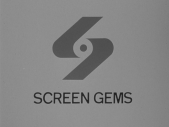 Screen Gems Television Distribution Still "S from Hell" (1965)
Screen Gems Television Distribution Still "S from Hell" (1965)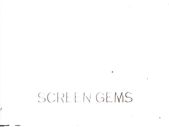
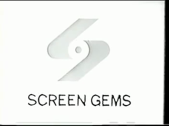 Screen Gems Television (1966)Screen Gems Television (1966)Screen Gems Canada Production
Screen Gems Television (1966)Screen Gems Television (1966)Screen Gems Canada Production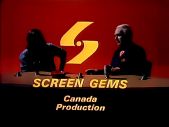
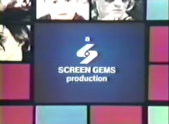 Screen Gems Television (1965)
Screen Gems Television (1965)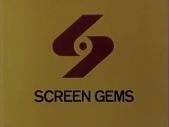 Screen Gems TelevisionScreen Gems Television (1971, Black Variant)
Screen Gems TelevisionScreen Gems Television (1971, Black Variant)
Screen Gems TelevisionScreen Gems Television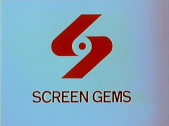
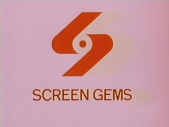
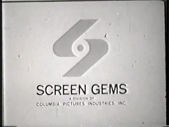
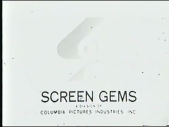 Screen Gems Television "S from Hell" (1974)Screen Gems (1972)Screen Gems Television (1974)
Screen Gems Television "S from Hell" (1974)Screen Gems (1972)Screen Gems Television (1974)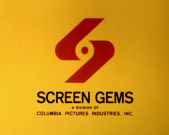
Screen Gems Television "S from Hell" (1974)Screen Gems (1974)
 Screen Gems Television Distribution Still "S from Hell" (1965)
Screen Gems Television Distribution Still "S from Hell" (1965)
 Screen Gems Television (1966)Screen Gems Television (1966)Screen Gems Canada Production
Screen Gems Television (1966)Screen Gems Television (1966)Screen Gems Canada Production
 Screen Gems Television (1965)
Screen Gems Television (1965) Screen Gems TelevisionScreen Gems Television (1971, Black Variant)
Screen Gems TelevisionScreen Gems Television (1971, Black Variant)Screen Gems TelevisionScreen Gems Television



 Screen Gems Television "S from Hell" (1974)Screen Gems (1972)Screen Gems Television (1974)
Screen Gems Television "S from Hell" (1974)Screen Gems (1972)Screen Gems Television (1974)
Screen Gems Television "S from Hell" (1974)Screen Gems (1974)
<iframe height="135" src="http://wikifoundrytools.com/wiki/closinglogos/widget/unknown/ec8215fd175e86842054fad6b3d8b2f997d926c0" width="179"></iframe><iframe height="135" src="http://wikifoundrytools.com/wiki/closinglogos/widget/unknown/6b701c426d791543da15d8be63cc0562bd7a46f5" width="241"></iframe><iframe height="135" src="http://wikifoundrytools.com/wiki/closinglogos/widget/unknown/4c68cb461e2f5c92045644620100b85268c4c6b9" width="179"></iframe><iframe height="135" src="http://wikifoundrytools.com/wiki/closinglogos/widget/unknown/0a22255c6af7f72cbe5df64cb5fdf93458d77b62" width="179"></iframe><iframe height="135" src="http://wikifoundrytools.com/wiki/closinglogos/widget/unknown/fa8feacd87ee178ab5a4ef02091f57b174442cae" width="179"></iframe><iframe height="136" src="http://wikifoundrytools.com/wiki/closinglogos/widget/genericvideo/482ddec10fc09093b481245fe4f6eeb91d5a8bfe" width="179"></iframe><iframe height="134" src="http://wikifoundrytools.com/wiki/closinglogos/widget/genericvideo/b8aaa3989665b5f05e9d1dcbf93ea29ebb14be34" width="196"></iframe><iframe height="134" src="http://wikifoundrytools.com/wiki/closinglogos/widget/genericvideo/57aad12e217cbc51a3535b0161b99af75ee03904" width="239"></iframe>
Nicknames: "S from Hell", "The Spiral S", "The Filmstrip S", "The Spiral S from Hell", "The Personification of All That Is Evil"
Logo: On a yellow background, two red parallelograms (or lines) come from the top and bottom of the screen, and the upper one is at a distance while the lower is closer. They fly towards each other, and the higher moves forward while the lower backs away. As they do so, they grow in length and wrap around a space where a red dot appears, forming a stylized "S". Under that, the text "SCREEN GEMS" zooms in.
Trivia:
- The "S" logo was designed and animated by Chermayeff & Geismar Associates of New York, a firm also responsible for the six-feathered NBC Peacock, the 1984 PBS logo, the Viacom "Wigga Wigga" logo, and the Chase Manhattan Bank logo, <a href="https://www.youtube.com/watch?v=svOrt6w55P4" target="_self">among other designs</a>.
- In the movie Once Upon a Time in Hollywood, the jingle can (partially) be heard on a television. Depending on how you feel, it may seem appropriate that said TV is somewhere on the Manson Compound. The logo's music is credited in the end credits of the movie.
Variants:
- There's an in-credit logo that's shown on the short-lived series Adventures of the Seaspray with the text "in association with" and "Screen Gems" in the same font as the credits.
- Another in-credit version was shown on The Pierre Berton Show with the text "SCREEN GEMS Canada Production" in the same font as the credits.
- Starting in late 1972, the byline "A DIVISION OF COLUMBIA PICTURES INDUSTRIES, INC." zooms up with "SCREEN GEMS" on most programs.
- When shown in black & white, the standard scheme appears to be a light gray screen and black "S" and words. When shown in color, the standard scheme appears to be a yellow screen, red "S", and black words. The words may or may not have actually been red at one time as well. On some prints of The Partridge Family, the "S" and the words were both black, attributed by some to film deterioration. However, when the Columbia byline was added, everything was changed to a light gray, and that color change appeared more natural. At the same time, other Screen Gems shows carried the normal color scheme (as did The Partridge Family when it was rerun on Hallmark Channel).
- Several shows in 1970 didn't have the name in bold.
- There is also a still variant of this logo with the phrase "DISTRIBUTED BY" in small print above "SCREEN GEMS".
- Another still variant with and without Columbia bylines respectively was seen on some shows like the first season of Police Story and Ghost Story (also known as Circle of Fear).
- Another variant has the byline appearing after the company logo/text animation stop. This variant was seen on early episodes of the miniseries QB VII.
- There is a variant where (possibly due to film deterioration), the screen is white and the "S" is bright. Seen on the pilot episode of Love on a Rooftop.
- Another variant is similar to the one above, but even brighter, making the "S" invisible and the words "SCREEN GEMS" barely visible. Seen on the Love on a Rooftop episode "The Six Dollar Surprise".
- Another variant like the ones above, contains the byline, has the "S" being partly invisible and the name and byline barely visible to see. This was spotted in a B&W print of The Paul Lynde Show episode "Togetherness".
- On a late '80s print of an episode of Occasional Wife, the animation and music of the logo was slightly faster than usual, probably due to time compression.
- A still version with a sky blue background was seen on S1 E5 of the short-lived series The Girl with Something Extra.
- Another still version with a pink background was seen on the pilot of the same show.
- On the Get TV airing of the TV special The Temptations Show, the logo strangely skips in the middle of its animation, speeding up the logo and music in the process.
FX/SFX: The parallelograms wrapping around the dot, and the name "SCREEN GEMS" zooming in.
Music/Sounds:
- Composed by Eric Siday, the entire score was performed on a Moog modular synthesizer (Siday was one of the first musicians to have one). It consists of 6 French horn-like notes, followed by 2 synth-brass quadruplets with the last note held.
- In 1970, the Siday theme was shortened so only three notes came before the tones. This shortened variant was sped-up and was used for the first short-lived Columbia Pictures Television logo.
Music/Sounds Variants:
- There is a version of the logo where no music is played, in other words, silence. This was seen on the 1971 television movie Brian's Song.
- The still version seen on Police Story had the end theme playing over the logo.
- The 1966 series Hawk (with Burt Reynolds), some later prints of The Peter Potamus Show, the 1966 edition of NFL Game of the Week, and the very first episode of Days of Our Lives, carried an alternate recording of the Eric Siday music, which had sharper, more "shrill" tones, almost sounding like a loud saxophone.
- On some first season episodes of I Dream of Jeannie (seen in syndication in the '70s and early '80s), as well as the half hour packaging of Batfink, an alternate trumpet fanfare played over the logo (said to be composed by Van Alexander, but this is not certain).
- In other cases, it used the closing theme of the show or TV movie.
- Some prints have the music more higher pitched.
- When ABC reran Bewitched on their daytime schedule in 1968, this logo had the "Dancing Sticks" music attached to it, probably due to a plastering error (on at least two episodes).
Availability: Pretty common.
- This logo has been beautifully restored on reruns of Bewitched, I Dream of Jeannie, and The Partridge Family on Antenna TV and FETV. Ironically, the DVD versions are not so lucky; except for one B&W episode (episode #22) of I Dream of Jeannie, the logos were removed on disc, but the short version complete with jingle has been restored starting with the seventh season DVDs of Bewitched, as well as the fourth season DVD of The Partridge Family. Don't expect the Columbia byline on the latter, though.
- The VHS release The Partridge Family: C'mon Get Happy! also preserves this logo, followed by the 1993 CPT logo. The only other DVDs with this logo are the 1971 TV movie Brian's Song and the 1974 miniseries QB VII, with theme music over it, plus the Columbia byline. This logo can be seen after every episode on the DVD release of Bridget Loves Bernie.
- This logo can also be found on every episode on the 2014 Mill Creek Entertainment DVD release of Gidget.
- The still variant with the Columbia byline can be found on most episodes of the first season of Police Story on DVD, released by Shout! Factory. It was also shown in an edited form on Fox Family reruns of The Partridge Family and in a sped-up form without music on The Hallmark Channel reruns of Bewitched. A good few episodes of Bewitched when aired on the UK satellite channel Living have this logo, often followed by the Sony Pictures Television International logo.
- The "Hawk S" can be seen at the Paley Center, and the 1966 edition of NFL Game of the Week, which can be found on YouTube. This was also seen on a episode of The Monkees on IFC, which was followed by the 1996 CTTD and 2014 Sony/SPT logos.
- Its first appearance was on the third and final season of The Farmer's Daughter, on ABC, and the fifth and final season of Hazel, on CBS.
Editor's Note: For a logo from the Sixties, this features very smooth animation, especially when compared to other logos of the time. However, this logo has gained somewhat of a cult following due to its notoriety for scaring some viewers, even enough to spawn a short mockumentary in 2010 called <a href="https://io9.gizmodo.com/5797378/watch-the-s-from-hell-a-short-documentary-about-people-scared-of-the-screen-gems-logo" target="_self">The S from Hell</a>.
